Shell scripting with KDE dialogs
Introduction and Scope
There are some misconceptions that Plasma is only a graphical environment. While it is true that Plasma is an outstanding desktop environment, the Unix heritage of command line and scripting is also well supported by Plasma. In particular, KDE applications can be controlled from the command line, and shell scripts can make use of some of the KDE widget set.
To use this tutorial, you'll need to have some basic familiarity with command line fundamentals, and be at least aware of shell scripting. Like any other programming environment, effective shell scripting requires solid knowledge of the environment. However, you should be able to make sense of the examples with only basic understanding. The downside to this is that if you are very familiar with shell scripting, some of the explanation is likely to be redundant.
This tutorial assumes that you are using the GNU bash shell, or something directly compatible. Users of other shells (especially fish and variants) may need to modify the examples.
Shell scripting techniques and usage varies a lot. Sometimes a script is only meant to be run by the system (e.g. as cron job), and other times scripts are really applications intended to be run by users. Plasma includes features that allow you to use some KDE functionality from a shell script, which can save work, and can also make your script feel like it is part of a nicely integrated application set.
As an example, consider something like a password dialog. If you need a user to enter a password, you can easily generate a dialog from your script that looks like the following:

kdialog Usage
Password Dialog
The key to using KDE dialogs in shell scripts is an application named kdialog. To
generate a password dialog as shown above, you could use the following command line.
kdialog --password "Please enter the server access code:"Let's look at the code in a bit more detail. The arguments passed to kdialog are used to control
the type of dialog that is produced and the parameter or parameters of that dialog box.
In the case of the password dialog, you use --password to specify the dialog type, and
then follow that with the parameter, which is the text that appears in the dialog box.
Shell Script Return Values
Each time you run kdialog (or any other application), there is a return value that indicates
whether the application ran as expected, or failed in some way. You can access this return
value as $?, as shown in the following example.
kdialog --password "Some Text"
echo $? # for Bash, 0 means successful
echo $status # for fish, 0 also means successfulNote
The $? variable is updated when each foreground process exits. If you need to use that variable later, you need to save it away.In this example, the return value is 0. It would be 1 if the Cancel button had been selected instead of the OK button.
Note
This is different from the convention used by the underlying widgets. If you are familiar with Qt widgets, this might be a bit confusing, however it is important to conform to the standard approach to shell scripting.Shell Script Return Value with Error
The convention is that negative numbers indicate failure, however the shell normally subtracts them from 256. This means that if you fail to specify a required argument, the system returns -2, and $? returns 254.
kdialog --password "Press Cancel to cause an error"
echo $? # or `echo $status` for fish
254Password Dialog, with Return Value Check
In a shell script, you might choose to test the return value after each invocation.
kdialog --password "Please enter the server access code:"
if [ $? = 0 ]; then
echo "You selected: OK"
else
echo "You selected: Cancel"
fiIn addition to the return value, you also get the password itself (assuming that you selected OK). After all, what is the point of a password dialog unless you can use the result?
Password Dialog Showing Redirection
For the password dialog, and other kdialog dialogs that provide input capabilities, the output is sent to standard output. This allows you to redirect the input to a file, or pipe it to another program. In the case of the password dialog, the text that is entered will be echoed as shown in
kdialog --password "Enter the password" > password.file
cat password.filePassword Dialog Using a Shell Variable
Instead of saving the result in a file, you can also use a shell variable. Note that you need to use the "backtick" notation - this key is normally found on the top left of English (British or American) layout keyboards, above the "7" key on French layout keyboards, and on the top right of German layout keyboards.
password=`kdialog --password "Enter the password"`
echo $passwordPassword Dialog with Title
While not shown in the previous examples, you can also use the --title option to specify
the title of the dialog box, as shown in the following example.
kdialog --title "ACAP entry" --password "Please enter the server access code:"Which results in:
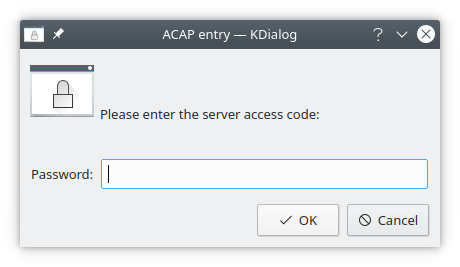
kdialog Dialog Types
The password dialog is just one of the many dialogs that kdialog can provide. This section provides an overview of each type, and describes the arguments you need to provide for each dialog type.
Basic message boxes
Basic message boxes are intended to provide status type information. There are variations to indicate the importance of the information (information, warnings, or errors). In each case, the argument is the text to provide, as shown in the following examples.
Information level message box
kdialog --msgbox "Password correct.\n About to connect to server"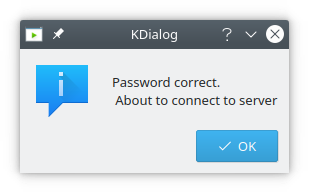
Sorry level message box
kdialog --sorry "Password incorrect.\n Will not connect to server"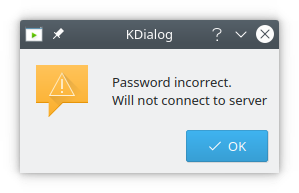
Error level message box
kdialog --error "Server protocol error."
The return value for these basic message boxes is zero.
While not used in these examples, you can use --title to set the window title
as well. This option can be used with any of the dialog types.
Non-Interrupting Notifications
kdialog supports the concept of a popup dialog that does not grab focus, called a passive popup.
--passivepopup dialog box
--passivepopup takes a text label to display, and a timeout in seconds. The display will be
automatically removed when the timeout has elapsed, or when
the user clicks on the popup.
kdialog --title "This is a passive popup" --passivepopup \
"It will disappear in about 10 seconds" 10
More Message Boxes
Sometimes you need more than the basic message box allows. Perhaps you have a potentially dangerous action, and you need to give the user a second chance. Or perhaps you just need a decision based on some information. kdialog provides some of the tools you might need.
--yesno message box
A --yesno type dialog is probably the simplest of this type, as shown below.
Like the simple message boxes previously, it requires a text string, which is
shown in the message box.
kdialog --title "Example YesNo dialog" --yesno "System is not \
currently connected.\n Do you want to connect now?"
--warningyesno message box
A variation on the --yesno dialog type is the --warningyesno, which modifies
the dialog box appearance a bit.
kdialog --title "Example YesNo warning dialog" --warningyesno "Are \
you sure you want to delete all that hard work?"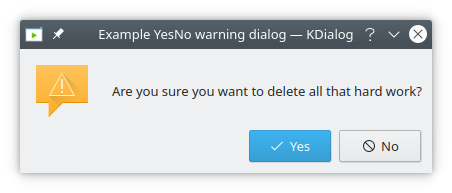
--warningcontinuecancel message box
A further variation is to use a --warningcontinuecancel dialog type, which
has the same usage, but has different button labels, and may fit some situations
better.

--yesnocancel message box
Another variation on the --yesno dialog type is to add a third option, as shown
in the --yesnocancel dialog type.
kdialog --title "YesNoCancel dialog" --yesnocancel "About to exit.\n \
Do you want to save the file first?"
--warningyesnocancel message box
There is also a --warningyesnocancel variation, as shown below.
kdialog --title "YesNoCancel warning dialog" --warningyesnocancel \
"About to exit.\nDo you want to save the file first?"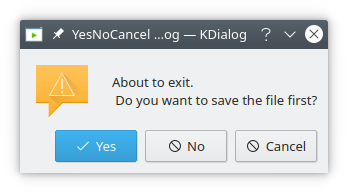
Suppressing the display of a dialog
Sometimes you will be using kdialog in a loop, or another situation where a message may be repeated. For example, you might be iterating through a list of files, and you raise an error for each file you cannot open because of permission problems. This can produce a really bad user experience because the error is repeated over and over.
The normal KDE way to deal with this is to allow the user to suppress the
display of a message in the future by selecting a checkbox, and kdialog allows
you to do this with the --dontagain option. This option takes a file name and
an entry name, and if the user selects the checkbox, then an entry is written
to the specified file, with the specified entry name.
Information level message box, with --dontagain
As an example, consider an information level message box for display of a file missing message.
kdialog --dontagain myscript:nofilemsg --msgbox "File not found."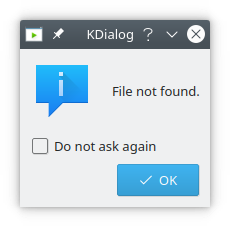
As noted above, an entry is written to a file when the user selects the checkbox.
cat ~/.kde/share/config/myscript
[Notification Messages]
nofilemsg=falseThe effect of this entry is to suppress future display of dialogs using that filename. In the example above, this means myscript:nofilemsg. This will take effect across all KDE applications, so be careful with the filename you use.
User Input dialogs
There are two basic free-form user input dialog types - the --inputbox type and the
--password type. The password dialog was covered in depth in a previous section - see
the Section called kdialog Usage.
--inputbox dialog box
The --inputbox dialog type requires at least one parameter, which is used as the text
in the dialog box.
kdialog --title "Input dialog" --inputbox "What name would you like to use?"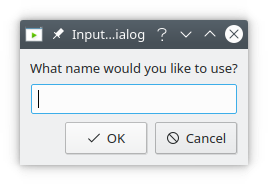
--inputbox dialog box with default parameter
kdialog --title "Input dialog" --inputbox "What name would you like to
use" "default Name"The return value depends on the button used. OK returns 0. Cancel returns 1.
The string that is entered (or modified / accepted if default text is used) is returned on standard output. If the user chooses Cancel, no output is sent.
Displaying files
--textbox dialog box
A common requirement for shell scripts is the ability to display a file. kdialog supports
this with the --textbox dialog type. This dialog type has one mandatory parameter, which
is the name of the file to be displayed. There are also two optional parameters which
specify the width and height of the dialog box in pixels. If these are not specified,
100 pixels by 100 pixels is used.
kdialog --textbox GPL-3.txt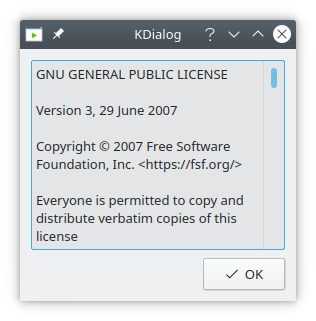
--textbox dialog box with dimensions
kdialog --textbox GPL-3.txt 512 256
Menu and Selection Dialogs
--menu dialog box
This section covers simple menus, checklists, radio buttons and combo-boxes. These are typically used for providing a choice of options. The menu is used to select one of a range of options. Each option is defined using two arguments, which you might like to think of as a key and a label. An example of the usage is shown below.
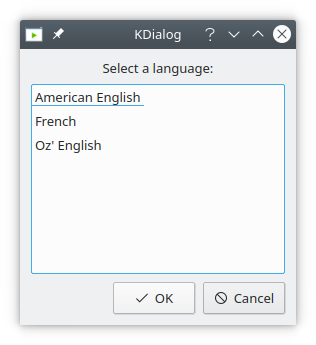
If you select the first option (in this case American English and press OK, then kdialog will send the associated key (in this case the letter a) to standard output. Note that the keys do not need to be lower case letters - you can equally use numbers, upper case letters, strings or the contents of shell variables.
As with the other examples we've seen, the return value depends on the button used. OK returns 0. Cancel returns 1.
--checklist dialog box
A checklist is similar to a menu, except that the user can select more than one option. In addition, a reasonable set of default selections can be provided. To do this, each option is defined using three arguments, which you might like to think of as a key, a label and a default state. An example of the usage is shown below.
kdialog --checklist "Select languages:" 1 "American English" off \
2 French on 3 "Oz' English" off
Clearly the result can contain more than one string, since the user can select more than
one label. By default, the results are returned on a single line, however you can use the
--separate-output to get a carriage return between each result. These two cases are
shown in the example below, where all of the options were selected in each case.
kdialog --checklist "Select languages:" 1 "American English" off \
2 French on 3 "Oz' English" off
"1" "2" "3"
kdialog --separate-output --checklist "Select languages:" \
1 "American English" off 2 French on 3 "Oz' English" off
1
2
3As for the menu example, the return value depends on the button used. OK returns 0. Cancel returns 1.
--radiolist dialog box
The radiolist is very similar to the checklist, except that the user can only select one of the options. An example is shown below:
kdialog --radiolist "Select a default language:" 1 "American \
English" off 2 French on 3 "Oz' English" off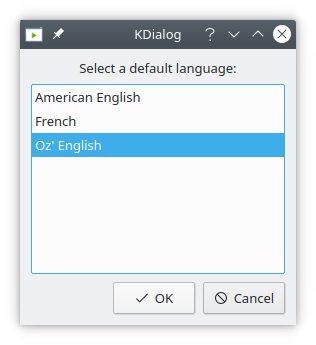
Note that if you try to turn on more than one option by default, only the last option turned on will be selected. If you don't turn on any of the options, and the user doesn't select any, kdialog will raise an assertion, so don't do this.
--combobox dialog box
A combobox is slightly different to the previous menu options in that it doesn't use keys, but instead just returns the selected text. An example is shown below:
kdialog --combobox "Select a flavour:" "Vanilla" "Chocolate" "Strawberry" "Fudge"
Chocolate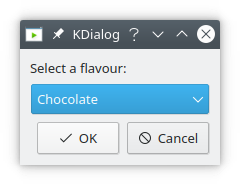
--slider dialog box
A slider allows you to select a value within a range. You can use arrow keys to move
left or right by one <step>.
# syntax: --slider <text> <min> <max> <step>
kdialog --slider "Select a Value" 0 100 10
File Selection Dialogs
This section covers dialogs to select files to open and save. The file dialogs are provided by your system. They can be provided with either paths or URLs and could utilize name or MIME type filtering.
--getopenfilename dialog box
The dialog to select a file to open is invoked with --getopenfilename or --getopenurl.
These two commands are used in the same way - only the format of the result changes,
so every example shown here can be applied to either format. You have to specify a
starting directory, and can optionally provide a filter. Here is a simple example that
filter out all .ogg files and accesses /usr/share/sounds/:
kdialog --getopenfilename /usr/share/sounds/ '*.ogg'
As for previous examples, the return value depends on the button used. OK returns 0. Cancel returns 1.
As mentioned previously, the result format varies between the two variations. This is shown below, in each case selecting the same file:
kdialog --getopenfilename .
/home/watson/a_file_name.xt
kdialog --getopenurl .
file:///home/watson/a_file_name.xtNote that the user can only select an existing file with these options. When you are opening many files, this can be useful to open the dialog in the directory that was navigated to last time. While you can potentially do this by extracting the directory from the filename, you can use a special KDE feature based on labels, as shown below:
kdialog --getopenfilename :label1
kdialog --getopenfilename :label1Each time you use the same label (with the colon notation), the last used directory will be used as the starting directory. This will normally improve the user experience. If that label hasn't been used before, the user's home directory will be used.
Note that the colon notation selects the last used directory for that label for the kdialog application. If you use two colons instead of one, the labeling scope becomes global and applies to all applications. This global scope is rarely what you want, and is mentioned only for completeness. Since not all files are applicable, it can be useful to restrict the files displayed. This is done using the optional filter argument. The best way to do this is with MIME types, as shown below:
--getopenfilename dialog box with MIME filter
kdialog --getopenfilename /usr/share/sounds/ 'audio/ogg audio/mp3 audio/wav'
--getopenfilename dialog box with name filter
You can also specify a range of name filters as shown below:
kdialog --getopenfilename . "C and C++ Source Files(*.cpp *.cc *.c)"
# Not specifying the filter's name also works.
kdialog --getopenfilename . "*.cpp *.cc *.c"
--getsavefilename dialog box
The --getsavefilename and --getsaveurl commands are directly analogous to the file
opening dialogs. A simple example is shown below:
kdialog --getsavefilename .
Unlike the file opening dialogs, the file saving dialogs allow the user to specify a filename that doesn't yet exist.
--getsavefilename dialog box with filter
As for the file opening dialogs, the file saving dialogs allow use of the colon notation, and also allow using MIME type filters and name filters, as shown below:
kdialog --getsavefilename :label1 "C and C++ Source Files (*.cpp *.cc *.c)"--getexistingdirectory dialog box
Sometimes you don't want to specify a filename, but instead need a directory. While you can specify
an "inode/directory" filter to a file open dialog, it is sometimes better to use
--getexistingdirectory, as shown below:
kdialog --getexistingdirectory .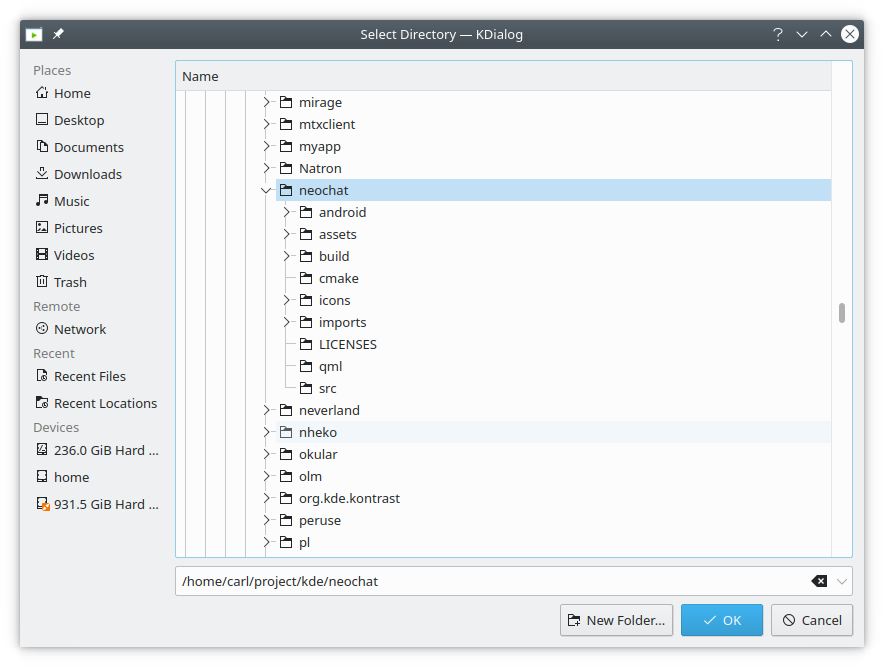
--getexistingdirectory does not provide any filtering, but it does provide
the same starting directory options, including the colon notation.
Progress Dialogs
A progress bar dialog is a useful GUI element when you have a process that will take a long time, and you want to reassure the user that things are happening correctly, rather than having the user believe that the machine may have locked up. If you ever find yourself thinking about writing an information dialog that says something like "..., this may take a while", it may be appropriate to use a progress bar dialog.
Because you need to make the progress bar change, you can't use kdialog in the normal
way. Instead, you set up the dialog, and use the qdbus tool to make the required changes.
--progressbar dialog box example
A simple use of the --progressbar flag is shown below.
dbusRef=`kdialog --progressbar "Initializing" 4`
qdbus $dbusRef Set "" value 1
qdbus $dbusRef setLabelText "Thinking really hard"
sleep 2
qdbus $dbusRef Set "" value 2
sleep 2
qdbus $dbusRef setLabelText "Thinking some more"
qdbus $dbusRef Set "" value 3
sleep 2
qdbus $dbusRef Set "" value 4
sleep 2
qdbus $dbusRef closeLine 1 runs kdialog, with an initial label of "Initialising", and a progress bar with
four elements. We capture the return value in a variable (which can be named just about
anything - I chose "dbusRef") for later use with the qdbus command. Line 2 sets the bar
to one stage along, and line 3 changes the label to "Thinking really hard". Line 4 is
just a delay (which would be when your script would perform the first part of the lengthy
task in a real application). Line 5 then increases the progress bar, followed by another
delay (representing more processing) in line 6. Line 7 changes the label, while lines 8
through 11 further increase the progress bar over a few seconds. Line 12 closes the progress
bar dialog - without this, it will remain displayed. If you'd prefer that the progress
bar dialog closed as soon as the bar gets to 100%, you can pass the setAutoClose true
argument to qdbus. If a task is taking a very long time, the user may decide that it
is better cancelled. kdialog can assist with this too, as shown in the example below.
Note
Theqdbus binary might be called qdbus-qt5 depending on your distribution.--progressbar dialog box example, with Cancel
dbusRef=`kdialog --progressbar "Press Cancel at Any time" 10`
qdbus $dbusRef showCancelButton true
until test "true" = `qdbus $dbusRef wasCancelled`; do
sleep 1
inc=$((`qdbus $dbusRef Get "" "value"` + 1))
qdbus $dbusRef Set "" "value" $inc;
done
qdbus $dbusRef closeAs in the previous example, the first line executes kdialog with some initial text, this time with 10 segments; and again we capture the return value in a variable for later use with DBus. Line 2 turns on the display of the Cancel button, which is off by default.
Lines 3 through 7 are a loop. Line three runs qdbus to check if the Cancel button has
been pressed, and if it hasn't been pressed yet, runs lines 4 through 6. Line 4 is again
a delay, representing processing in a real application. Line 5 runs a qdbus command to get the
current progress bar setting, and adds one to the count (this could have just been kept as a
counter variable, but this approach shows a different qdbus usage). Line 6 then sets the
progress bar to the incremented value. Line 8 closes the progress bar dialog if the
Cancel button has been pressed.